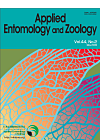最新号
選択された号の論文の22件中1~22を表示しています
- |<
- <
- 1
- >
- >|
Regular Papers
-
原稿種別: Regular Paper
2010 年 45 巻 4 号 p. 533-539
発行日: 2010/11/25
公開日: 2010/11/30
PDF形式でダウンロード (683K) -
原稿種別: Regular Paper
2010 年 45 巻 4 号 p. 541-550
発行日: 2010/11/25
公開日: 2010/11/30
PDF形式でダウンロード (988K) -
原稿種別: Regular Paper
2010 年 45 巻 4 号 p. 551-556
発行日: 2010/11/25
公開日: 2010/11/30
PDF形式でダウンロード (501K) -
原稿種別: Regular Paper
2010 年 45 巻 4 号 p. 557-567
発行日: 2010/11/25
公開日: 2010/11/30
PDF形式でダウンロード (1831K) -
原稿種別: Regular Paper
2010 年 45 巻 4 号 p. 569-574
発行日: 2010/11/25
公開日: 2010/11/30
PDF形式でダウンロード (424K) -
原稿種別: Regular Paper
2010 年 45 巻 4 号 p. 575-577
発行日: 2010/11/25
公開日: 2010/11/30
PDF形式でダウンロード (411K) -
原稿種別: Regular Paper
2010 年 45 巻 4 号 p. 579-585
発行日: 2010/11/25
公開日: 2010/11/30
PDF形式でダウンロード (537K) -
原稿種別: Regular Paper
2010 年 45 巻 4 号 p. 587-592
発行日: 2010/11/25
公開日: 2010/11/30
PDF形式でダウンロード (531K) -
原稿種別: Regular Paper
2010 年 45 巻 4 号 p. 593-599
発行日: 2010/11/25
公開日: 2010/11/30
PDF形式でダウンロード (676K) -
原稿種別: Regular Paper
2010 年 45 巻 4 号 p. 601-608
発行日: 2010/11/25
公開日: 2010/11/30
PDF形式でダウンロード (561K) -
原稿種別: Regular Paper
2010 年 45 巻 4 号 p. 609-614
発行日: 2010/11/25
公開日: 2010/11/30
PDF形式でダウンロード (743K) -
原稿種別: Regular Paper
2010 年 45 巻 4 号 p. 615-620
発行日: 2010/11/25
公開日: 2010/11/30
PDF形式でダウンロード (576K) -
原稿種別: Regular Paper
2010 年 45 巻 4 号 p. 621-626
発行日: 2010/11/25
公開日: 2010/11/30
PDF形式でダウンロード (420K) -
原稿種別: Regular Paper
2010 年 45 巻 4 号 p. 627-633
発行日: 2010/11/25
公開日: 2010/11/30
PDF形式でダウンロード (506K) -
原稿種別: Regular Paper
2010 年 45 巻 4 号 p. 635-640
発行日: 2010/11/25
公開日: 2010/11/30
PDF形式でダウンロード (475K) -
原稿種別: Regular Paper
2010 年 45 巻 4 号 p. 641-652
発行日: 2010/11/25
公開日: 2010/11/30
PDF形式でダウンロード (21830K)
-
2010 年 45 巻 4 号 p. i-vi
発行日: 2010/11/25
公開日: 2010/11/30
PDF形式でダウンロード (415K) -
2010 年 45 巻 4 号 p. IX1
発行日: 2010/11/25
公開日: 2010/11/30
PDF形式でダウンロード (439K) -
2010 年 45 巻 4 号 p. H42
発行日: 2010/11/25
公開日: 2010/11/30
PDF形式でダウンロード (118K) -
2010 年 45 巻 4 号 p. H43
発行日: 2010/11/25
公開日: 2010/11/30
PDF形式でダウンロード (122K) -
2010 年 45 巻 4 号 p. H44
発行日: 2010/11/25
公開日: 2010/11/30
PDF形式でダウンロード (140K) -
2010 年 45 巻 4 号 p. H41
発行日: 2010/11/25
公開日: 2010/11/30
PDF形式でダウンロード (221K)
- |<
- <
- 1
- >
- >|
